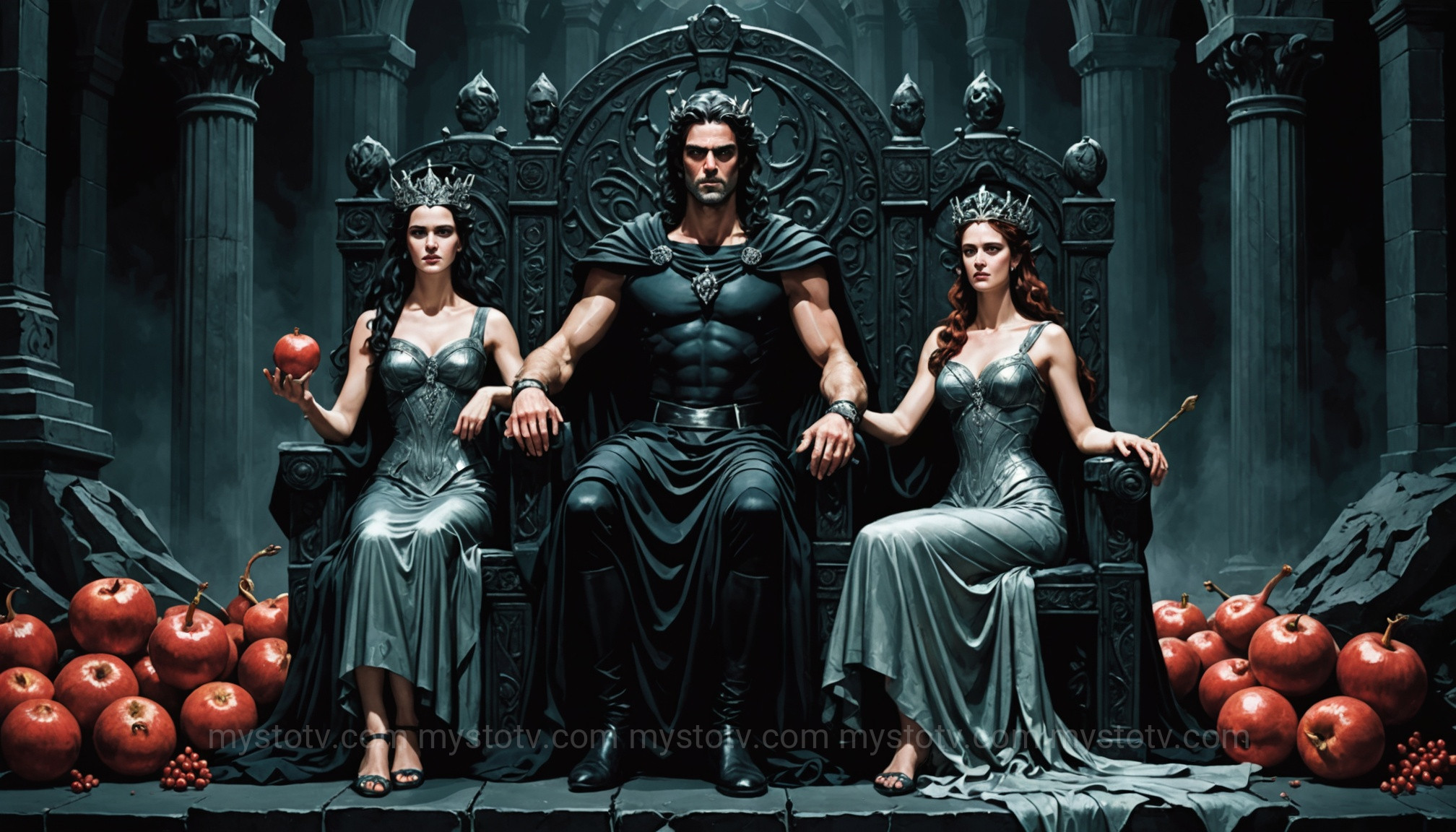I remember the first time I encountered the story of Persephone. It was in a beautifully illustrated children’s book of Greek myths. In that version, a lonely god of the Underworld was so captivated by a beautiful goddess that he took her to be his queen. It felt like a dark fairy tale. But years later, studying the original texts in a college literature class, the stark reality hit me. The language wasn't one of courtship; it was one of violence and grief. This gap between the softened modern tale and the raw ancient myth sparked a long-standing fascination. Providing a clear persephone and hades story summary isn't just about retelling events; it's about navigating a complex narrative that sits uncomfortably between a traumatic abduction and what some now interpret as a profound, transformative romance.
Contents
- 1 The Traditional Persephone and Hades Story Summary: A Tale of Abduction
- 2 Reinterpreting the Persephone and Hades Story Summary: Seeds of a Romance?
- 3 Key Symbols and Their Meanings in the Persephone and Hades Story Summary
- 4 Modern Retellings and the Evolving Persephone and Hades Story Summary
- 5 Frequently Asked Questions (FAQ)
- 6 References
- 7 Conclusion: The Enduring Power of an Ambiguous Myth
The Traditional Persephone and Hades Story Summary: A Tale of Abduction
To understand the debate, we must first turn to the primary source, the Homeric Hymn to Demeter, which dates back to the 7th or 6th century BCE. This ancient text presents a narrative that is, by any modern standard, an account of kidnapping and assault. It’s the foundational version of the myth and frames the entire conflict through the lens of loss and violation.

The Violent Seizure: Zeus's Complicity
The story begins with Persephone, known then as Kore (the maiden), gathering flowers in a meadow with the Oceanids. The hymn explicitly states that her father, Zeus, had given Hades permission to take her as his bride, all without the consent or knowledge of Persephone or her mother, Demeter. Lured away from her companions by a wondrous narcissus flower planted by Gaia at Zeus's request, the earth suddenly gapes open. Hades, King of the Underworld, erupts from the chasm in his golden chariot and seizes the screaming goddess, carrying her against her will down to his dark realm. The text is unambiguous: she was "unwilling," and she cried out for her father, but he had already sanctioned the act.
A Mother's Despair: Demeter's Retaliation
The core of the Homeric Hymn is not about Hades or even Persephone, but about Demeter, the goddess of the harvest and agriculture. Hearing her daughter's faint cries, Demeter is plunged into a profound and desperate grief. For nine days, she wanders the earth with torches in hand, refusing to eat, drink, or bathe, searching for any news of her child. When she finally learns the truth from Helios, the all-seeing sun god, her sorrow turns to a cold, devastating rage. She forsakes her divine duties on Mount Olympus and, disguised as an old woman, roams among mortals. More critically, she forbids the earth to produce any crops. A terrible famine grips the world, and humanity faces extinction. This act of divine blackmail is the only thing that forces Zeus to finally act and command Hades to return Persephone.
The Pomegranate Pact: A Trick or a Choice?
Here we find the myth’s most crucial turning point. Just as Hermes arrives to escort Persephone back to the world of the living, Hades offers her a pomegranate seed. The hymn says he "stealthily gave her a sweet pomegranate seed to eat." Eating any food in the Underworld would magically bind the consumer to that realm forever. Persephone eats it—the number of seeds varies from one to several depending on the version—thus sealing her fate. This act is central to the abduction narrative. It is presented as a final trick by Hades to ensure she cannot leave him permanently. From this perspective, Persephone is a victim to the very end, manipulated by a powerful male god. However, as we will explore, this moment is also a key area for reinterpretation.
Reinterpreting the Persephone and Hades Story Summary: Seeds of a Romance?
While the ancient sources heavily favor the abduction narrative, modern interpretations and a closer reading of the myth’s subtext have allowed for a more romantic view to flourish. This perspective doesn't necessarily erase the initial violence but suggests a transformation of the relationship from one of captor and captive to one of king and queen, and perhaps even to a genuine partnership. This reading often focuses on what isn't explicitly stated in the hymn—the time Persephone spends in the Underworld and the power she eventually wields.

Examining Hades's Character and Motivations
To see a romance, one must first re-examine Hades. In popular culture, he is often conflated with a Satan-like figure—evil, demonic, and cruel. Yet, in Greek mythology, Hades is not inherently evil. He is a grim and powerful god, but also a just one, ruling his realm with a stern and steady hand. Unlike his brothers Zeus and Poseidon, who are infamous for their countless affairs, rapes, and betrayations of their wives, Hades is depicted as almost exclusively monogamous to Persephone. Proponents of the romance angle argue his "abduction" was the only way a reclusive, feared god knew how to get a wife, a violent act born of loneliness rather than pure malice. He offered her not just marriage but a throne and dominion over an entire kingdom—a stark contrast to being a lesser goddess on Olympus.
Persephone's Growing Agency and Power
This is perhaps the most compelling argument for a romantic or at least empowering interpretation. The story is one of a profound transformation. She enters the Underworld as Kore, the maiden, a passive girl defined by her mother. She emerges as Persephone, the Dread Queen of the Underworld. She isn't a prisoner; she is a ruler. In other myths, such as the tale of Orpheus and Eurydice, it is Persephone whose heart is moved by Orpheus's song and who persuades Hades to give him a chance. She is shown to have authority and influence. The romance reading suggests that she grew into her power in the Underworld, finding a strength and identity she never had under her mother's shadow. In this view, she and Hades become a power couple, ruling their domain as equals.
The Nuance of Ancient Greek "Marriage"
Understanding the historical context is crucial. In ancient Greece, marriage among the elite was rarely about love or consent from the bride. It was a transaction between the father and the suitor. While Hades's method was exceptionally dramatic, the fundamental act of a father giving his daughter away without her consent was the societal norm. This doesn't excuse the violence, but it does place it within a different cultural framework. The abduction can be seen as a mythological, divine-scale representation of the often-traumatic experience of marriage for ancient Greek women—being taken from their maternal home and delivered to a husband's home to begin a new life. Within that framework, finding respect, power, and a functional partnership with that husband could be seen as a successful outcome.
Key Symbols and Their Meanings in the Persephone and Hades Story Summary
The debate between romance and abduction is deepened by the rich symbolism woven throughout the myth. The meaning of these symbols is not fixed; they can be interpreted to support either side of the argument, revealing the story's inherent complexity.

The Pomegranate: Symbol of Indissoluble Bonds and Fertility
The pomegranate is the most potent symbol in the myth. For the abduction narrative, it is the instrument of a final trick, ensuring Persephone's imprisonment. It represents a loss of innocence and a permanent tie to her captor. However, the fruit carries dual meanings. In ancient cultures, the pomegranate, with its abundance of seeds, was a powerful symbol of fertility, life, and marital union. By eating it, Persephone doesn't just bind herself to the Underworld; she consumes the symbol of her new status as a wife and a queen who bridges the worlds of the living and the dead. The act can be read not as submission, but as an acceptance of her new role and the power that comes with it. Her growing agency and power is fundamentally linked to this act.
The Narcissus Flower: Innocence and Deception
The narcissus flower that lures Persephone away represents the deceptive nature of beauty and the transition from the world of childhood innocence to adult reality. It is a trap, engineered by the patriarchal powers of Zeus and Hades to isolate her. Its beauty masks a violent intent, symbolizing the perilous journey from maidenhood to womanhood in a world controlled by others' designs. It underscores the lack of consent and the predatory nature of her seizure, strongly supporting the abduction interpretation.
The Duality of the Underworld: A Prison or a Kingdom?
How one views the Underworld itself heavily influences their interpretation of the story. Is it a dark, lifeless prison, a Hellenic hell where a goddess of flowers is doomed to wither? Or is it a vast, stable, and powerful kingdom? As ruler of the Underworld, Hades presides over all the wealth of the earth—the minerals and precious metals—and holds sway over every mortal soul. By becoming his queen, Persephone gains dominion over this immense realm. The Underworld can be seen not as her prison, but as her domain, the source of her power and authority as the "Dread Queen."
Modern Retellings and the Evolving Persephone and Hades Story Summary
The ambiguity of the myth has made it fertile ground for modern creators. In the 21st century, there has been an explosion of retellings in novels, webcomics, and even stage productions, and the vast majority have leaned heavily into the romance narrative. This cultural shift tells us as much about our own time as it does about the ancient myth.
Popular works like Rachel Smythe's webcomic Lore Olympus, Scarlett St. Clair's novel series A Touch of Darkness, and the Tony Award-winning musical Hadestown all reframe the persephone and hades story summary as a love story. They often portray Hades as a misunderstood, emotionally complex figure and Persephone as a young woman with untapped power who finds freedom, love, and self-actualization away from an overbearing mother or a corrupt Olympus. The initial abduction is often softened, consensual, or re-contextualized as a rescue.
Why is this interpretation so popular now? It aligns with contemporary desires for narratives of female empowerment. It transforms a story of female victimhood into one of agency, choice, and finding power in unexpected places. This modern romance allows readers to engage with the "dark" and "forbidden" (the archetype of the god of death) in a safe, romantic context. It fulfills a fantasy of being seen for one's true potential and loved by a powerful partner who offers not a cage, but a kingdom. While these retellings are compelling, it is essential to remember they are re-interpretations, consciously choosing to emphasize the seeds of romance over the roots of abduction found in the original sources.
Frequently Asked Questions (FAQ)
Did Persephone willingly eat the pomegranate seeds?
The Homeric Hymn to Demeter is ambiguous. It states Hades "stealthily gave her" the seed to eat, which implies deception. However, other later sources, like Ovid's Metamorphoses, suggest she wandered into a garden and plucked the fruit herself, implying more agency or at least carelessness. The debate over her willingness is central to the myth's interpretation. The traditional view holds she was tricked, while romantic interpretations often depict it as a conscious choice to claim her power and remain with Hades.
Was Hades considered evil by the ancient Greeks?
No, Hades was not considered evil in the way a figure like the Christian Devil is. He was one of the three great sons of Cronus, alongside Zeus and Poseidon. The Greeks feared him as the inevitable ruler of the dead, and they often avoided even saying his name, calling him "Plouton" (The Rich One) instead. But he was seen as just and impartial in his rule over the Underworld, not actively malevolent or a tempter of mortals. His primary role was to maintain the balance between the living and the dead.
Why is the romance interpretation of the Persephone and Hades story summary so popular today?
The romance interpretation resonates with modern audiences for several reasons. It aligns with the popular "dark romance" and "enemies-to-lovers" tropes in fiction. More significantly, it reframes a story of female victimhood into one of empowerment, where Persephone finds her strength and becomes a powerful queen. This appeals to a contemporary desire for strong female characters who define their own destinies, even when their circumstances begin with trauma.
References
- Homeric Hymn 2 to Demeter. (c. 7th-6th Century BCE). As translated by Hugh G. Evelyn-White, 1914.
- Atsma, Aaron J. "Persephone." Theoi Project, 2000-2017. https://www.theoi.com/Khthonios/Persephone.html
- Ovid. Metamorphoses. (8 CE). Book V, lines 385-571. Many translations available.
- Burkert, Walter. Greek Religion. Harvard University Press, 1985. (Provides scholarly context on Greek gods and rituals).
Conclusion: The Enduring Power of an Ambiguous Myth
So, is the persephone and hades story summary a romance or an abduction? The most honest answer is that it is both, and it is neither. The foundational myth, viewed through a modern lens, is undeniably a story of violence, abduction, and trauma. The text leaves little room for doubt on that point. Yet, woven into the narrative are threads of transformation, power, and partnership that have allowed for a radically different interpretation to take root and flourish, especially in our modern era. The story’s enduring power lies precisely in this ambiguity. It forces us to confront uncomfortable questions about consent, power dynamics, and the capacity for love and strength to emerge from the darkest of beginnings. Ultimately, whether one sees a victim or a queen, a prison or a kingdom, a villain or a lonely god, the story of Persephone and Hades remains one of mythology’s most complex and compelling tales.